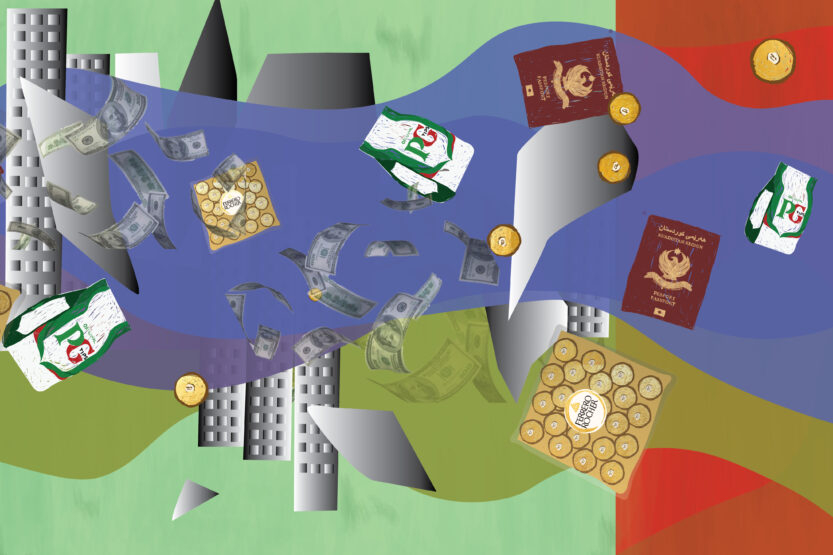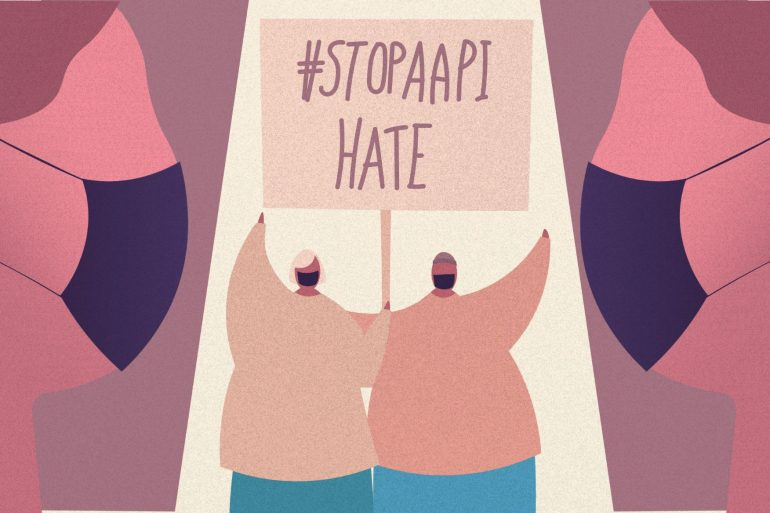Two years ago, I moved to rural Perthshire. Being enveloped by nature was new to me. When I started hearing her melodies, and becoming curious as to who might be singing them, I embarked on learning more about birds and their habitat. From here, my world expanded to other mammals, mushrooms and trees – until I looked at the entire ecosystem and felt compelled to protect it.
Because this is the dominant narrative in British conservation – our landscapes must be preserved. They must be untouched by humans (for we are separate to nature), and unspoiled by anything, or anyone, that doesn’t belong.

The focus on origin
“We need to get rid of the invasive American grey squirrels because they are a threat to our native reds,” a conservation officer tells me during an introductory meeting. Shortly after settling in Scotland, I had joined local conservation efforts as I was keen to get involved. But what struck me was this unequivocal approach to nature – these species are “good,” those are “bad.” And if they are bad, they must be eradicated.
As a migrant and person of mixed heritage, I’ve often struggled with the xenophobic language that surrounds UK conservation. Species that are considered “invasive” are linked to being “non-native”, often with their country of origin mentioned to emphasise their foreignness, like Japanese knotweed and Himalayan balsam. Blame is put on the immigrant.
This is, in part, driven by government efforts. The Non-Native Species Secretariat (NNSS) represents the governments of England, Scotland and Wales. It is dedicated to taking action against the “threat of invasive non-native species.” This rhetoric mirrors Suella Braverman’s racist comments describing the movement of people crossing the Channel to seek asylum as an “invasion.” And it is not a coincidence.

Botanist Hewett Cottrell Watson was one of the first to introduce categories as a way to describe plants in Britain – these included “native”, “denizen” and “alien.” As a former legal apprentice, he intentionally drew these terms from the language of citizenship law at the time.
My local conservation groups are dominated by older white people – as are the boards of many national conservation organisations in what is the second least diverse sector in the UK. Therefore, it is particularly marginalising to be surrounded by this narrative as often the only person of colour. But the issue is more than just with language: it is also the harmful ideals that these are linked to.
Ecofascism and Nazi legacies
An insidious part of British nationalism is the notion of a “green and pleasant land.” Our landscape forms part of the national identity, and it is often used to assert other racist claims about who belongs in this country and who doesn’t. And these ideals have underpinned many modern scientific fields – such as ecology, which stemmed from Nazi environmentalism.
In 19th century Germany, ethnic nationalism gained popularity in what is known as the völkisch movement – a fascist vision of social change that combined racist and antisemitic thinking with nature mysticism. During this time, German naturalist and eugenicist Ernst Haeckel coined the term “ecology” and developed it as a scientific discipline. He also used Darwin’s evolutionary theories to legitimise the idea of Nordic racial superiority as scientific fact. This became a key component that helped give the racism of the völkisch movement scientific credibility and, ultimately, power at the state-level.
This is not to say that the conservation movement in the UK today is fascist. But it is unclear where prioritising biodiversity begins and preserving the local ends. Particularly when vilification is selective, with many non-Indigenous species – such as roses and wisteria – considered as quintessentially English.
Mainstream efforts do not allow for this narrative to be challenged: environmentalism is often peddled as scientific and unbiased, and therefore impenetrable. However, it is always political.

Colonialism in conservation
What we don’t hear about is how these “invasive” species migrated in the first place, only that they “escaped” into our countryside (because nature, unsurprisingly, does not adhere to the arbitrary borders that we impose).
But what unites many of these species is colonialism. Botany might be thought of as a passive activity, but its practice emerged from Europe’s colonial voyages. And the UK’s botanical gardens played an active role in this violence.
By the 18th century, botanical gardens had already established sending “plant collectors” across the world to discover new species. But they were also looking for crops that could be exploited for economic gain. These species would be brought back to the UK, where a hybrid would be produced before exporting the new specimens to other parts of the world to be grown in a plantation system. This involved clearing land in that country, destroying its existing ecosystem, and growing the new species as a monoculture.
Whole environments were changed through the imposition of these species, which had been planted with financial return in mind. And the movement of these plants was entwined with the transportation of people: to work on these plantation systems, colonisers trafficked people from other countries through chattel slavery or indentured labour.
This is how crops like oil palms have been commercialised today. Originally indigenous to West and Southwest Africa, in the 19th century botanists at Kew Gardens brought back seeds from the Niger Delta, where they dismissed local cultivation methods as “inefficient” and “unproductive.” The plants were transported to Southeast Asia at the advice of the British director of Singapore’s Botanic Gardens – because they would give a “good return.”
Mass deforestation in Malaysia and Indonesia for oil palm plantations continues to this day. This loss – of some of the world’s most biodiverse forests — has directly led to its inhabitants like the orangutan becoming a critically endangered species.
The legacy of extraction
We see the impact of this exploitation today, both at home and abroad. Plants have since been given Latin names, with their Indigenous knowledge and practices having been erased. The ecological violence perpetrated by Europe has influenced other colonial movements, including the founders of Zionism which we see in the Israeli destruction of Indigenous plants and their severance of the relationship between Palestinian people with land.
But this context does not form part of the British narrative. Instead, the UK makes itself out to be the victim, rather the perpetrator – and this is incredibly dangerous.

In April, I participated in a guided visit of the Royal Botanic Garden Edinburgh, organised by Artworkers For Palestine Scotland. The tour gave an alternative perspective to the exhibition Silent Archive, which had set out to uncover “painful truths” about humanity’s relationship with the botanical world.
Subscribe to shado's weekly newsletter
Exclusive event news, job and creative opportunities, first access to tickets and – just in case you missed them – our picks of the week, from inside shado and out.

But what I found missing from the exhibition, however, was any painful truths about The Botanics’ own history, what it is doing to right these wrongs, and any interrogation of its links to Zionist organisations.
To me, the exhibition demonstrated that colonial botany is alive and well. It omitted Palestinian voices, including that of art collective Sakiya, whose work had been displayed at The Botanics just two years earlier.
Sakiya’s exhibition, In the Eddy of the Stream, detailed how the British Empire reclassified 33 plant species as “weeds” during its occupation of Palestine, because they were seen as a threat to the UK’s wheat monocultures. These species of edible and medicinal plants are vital to Palestinians. But these histories have been erased. And today they are still categorised in The Botanics’ online catalogue as plants “from Israel.”
The problems with our current approach
For over a century, we have seen Israel intentionally plant non-native species, changing the acidity of the soil so it becomes uninhabitable for Indigenous plants and endangers native animals. This has completely changed Palestine’s ecosystem.
Britain’s colonial past and its role in supporting Zionism – including Israel’s ongoing ecocide – is not part of conversations about biodiversity. Instead, our narcissistic and whitewashed narrative has concentrated on “invasives” in a way that in fact dilutes their violent uses, ignoring how they are connected to other forms of oppression.
The landscape of the UK has been controlled by its own desire to dominate. Non-Indigenous plants (considered as having been here for less than 8,000 years) are more likely to grow in habitats that have been disturbed or damaged by humans than in “natural” environments.
While some of their effects may indeed cause environmental concern, they have also become integral to our ecosystem, supporting bees, butterflies and other Indigenous invertebrates — many of which are also considered at risk.
As permaculture designer Tao Orion writes in her book Beyond the War on Invasive Species, “turning back the clock on the ecosystem evolution is not only impossible; it distracts us from understanding how the ecosystems of today are responding to real and serious challenges.”
So rather than killing every grey squirrel in Scotland, we should perhaps be looking at whether initiatives like these are effective or sustainable, when changes in land use, forest fragmentation and human impact have also contributed to the decline in red squirrels.

By honing in on a single species in isolation – whether “native” or “invasive” – other environmental, social and political factors are disregarded.
For example, one of my local nature reserves – an enclosed estuary home to thousands of birds – allows visitors to shoot geese, ducks and waders. These are the same species which are found on information boards in the wildlife hides. An arbitrary straight line through the water basin changes the site from being a sanctuary to a shooting ground: the reserve only protects wildlife until it interferes with sport, tourism and tradition.
In the UK, nature is still predominantly commodified. Conservation is caveated by which species we determine to be useful, where and when. And this is also driven by economic reasons.
How British conservation needs to change
The PR ignores the bigger picture in many other ways. Last year, the Botanical Society of Britain and Ireland published the results of their 20-year research project, Plant Atlas 2020. One of the main findings was that “non-native” plant species now outnumber “native” plant species in the wild – but many of their habitats have actually been impacted by changes in UK agriculture since the 1950s.
This feels like such a crucial element that is missing. Why is there a government-backed campaign on “invasive species week,” but not on the huge impact of farming on biodiversity? Why are resources being spent to eradicate certain species, but not on phasing out the thousands of tons of chemical pesticides used each year that are highly toxic to bees and other wildlife?
The answer lies in capitalism and mass consumption. Part of the NNSS’s focus is on species that are “costly to the economy.” Government policies have favoured increasing the industrialisation of agriculture, mass-produced food and dependence on fossil fuels, all of which are major drivers of climate change. Soil erosion and loss of biodiversity are collateral damage.
We must develop a more holistic approach to conservation that recognises the interconnecting factors of our ecosystem. As Tao Orion adds: “ecosystems should be restored and enriched by every action we take and decision we make, including the methods we use to procure our food, shelter, water and other necessities of daily life.”
We must also stop seeing nature through a colonial lens and confront our past in order to understand why the current approach is harmful. We need to recognise the global state of conservation and how it is linked to climate change, and we have to hold industry and government accountable if we are to make systemic change.
While I still remove “invasives” in my garden on occasion, I’m more concerned about collective ethical and regenerative efforts, achieving food justice through community initiatives, and decolonising our relationship to nature. So when my Himalayan balsam starts flowering in the coming weeks, before I pull it out, I’ll be tossing its seeds in a salad.
What can you do?
Do:
- Support intersectional environmental organisations lobbying government and industry for climate justice, such as Friends of the Earth and Greenpeace
- Find out more about Pesticide Action Network UK
Read:
- Dispersals: On Plants, Borders and Belonging by Jessica J. Lee
- How Have the Forests of “Israel” Swallowed Our Unpopulated Land?
- Beyond the War on Invasive Species by Tao Orion
- Braiding Sweetgrass: Indigenous Wisdom, Scientific Knowledge, and the Teachings of Plants by Robin Wall Kimmerer
- Other shado articles on decolonisation, climate justice, indigenous movements and Palestine
Listen:
- shado-lite’s podcast episode on settler colonialism in historic Palestine
- The Botanical Mind podcast episode on the coloniality of planting
Watch:
- Foragers (2022), a Palestinian documentary which interrogates settler colonial power and narratives of conservation

“Native” – The Poppy flower is a symbol of Remembrance and support for military forces, which is represented as ‘native’ in the UK. The Poppy is native to Palestine and holds many deep symbolism, e.g. Palestinian heritage, resistance, resilience and hope.
“Denizen” – The Cherry Blossom is native to the entirety of eastern Asia, also called Sakura in Japan. The flowers are grown in the UK and perfectly adapted to the British spring weather.
“Alien” – The Faqqua Iris is the national flower of Palestine which thrives in the special climate of the Faqqua mountains. The flower is rarely cultivated as an ornamental plant in temperate regions, for example the UK.”















